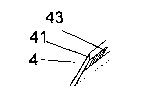Une partie des informations de ce site Web a été fournie par des sources externes. Le gouvernement du Canada n'assume aucune responsabilité concernant la précision, l'actualité ou la fiabilité des informations fournies par les sources externes. Les utilisateurs qui désirent employer cette information devraient consulter directement la source des informations. Le contenu fourni par les sources externes n'est pas assujetti aux exigences sur les langues officielles, la protection des renseignements personnels et l'accessibilité.
L'apparition de différences dans le texte et l'image des Revendications et de l'Abrégé dépend du moment auquel le document est publié. Les textes des Revendications et de l'Abrégé sont affichés :
| (12) Demande de brevet: | (11) CA 2503240 |
|---|---|
| (54) Titre français: | LAME A COUCHAGE RESISTANTE A L'USURE OU LAME CORRESPONDANTE DESTINEE AU TRAITEMENT D'UNE BANDE PAPIER |
| (54) Titre anglais: | WEAR RESISTANT COATING BLADE OR A CORRESPONDING BLADE FOR THE TREATMENT OF A PAPER WEB |
| Statut: | Réputée abandonnée et au-delà du délai pour le rétablissement - en attente de la réponse à l’avis de communication rejetée |
| (51) Classification internationale des brevets (CIB): |
|
|---|---|
| (72) Inventeurs : |
|
| (73) Titulaires : |
|
| (71) Demandeurs : |
|
| (74) Agent: | ROBIC AGENCE PI S.E.C./ROBIC IP AGENCY LP |
| (74) Co-agent: | |
| (45) Délivré: | |
| (86) Date de dépôt PCT: | 2003-10-21 |
| (87) Mise à la disponibilité du public: | 2004-05-06 |
| Licence disponible: | S.O. |
| Cédé au domaine public: | S.O. |
| (25) Langue des documents déposés: | Anglais |
| Traité de coopération en matière de brevets (PCT): | Oui |
|---|---|
| (86) Numéro de la demande PCT: | PCT/FI2003/000781 |
| (87) Numéro de publication internationale PCT: | FI2003000781 |
| (85) Entrée nationale: | 2005-04-20 |
| (30) Données de priorité de la demande: | ||||||
|---|---|---|---|---|---|---|
|
L'invention concerne une lame de traitement (4) telle qu'une lame à couchage, destinée au traitement d'une bande papier et pourvue d'un revêtement résistant à l'usure (42,). La zone à coucher de cette lame a été rendue rugueuse avant le procédé de revêtement. Les traces de rugosité (43) sont perpendiculaires à la direction longitudinale de la lame de traitement.
A treatment blade (4), such as a coating, doctor or creping blade, designated
for the treatment of a paper web and provided with a wear resistant coating
(42), in which blade the area to be coated has been roughened before the
coating process. The roughening traces (43) are perpendicular to the
longitudinal direction of the treatment blade.
Note : Les revendications sont présentées dans la langue officielle dans laquelle elles ont été soumises.
Note : Les descriptions sont présentées dans la langue officielle dans laquelle elles ont été soumises.

2024-08-01 : Dans le cadre de la transition vers les Brevets de nouvelle génération (BNG), la base de données sur les brevets canadiens (BDBC) contient désormais un Historique d'événement plus détaillé, qui reproduit le Journal des événements de notre nouvelle solution interne.
Veuillez noter que les événements débutant par « Inactive : » se réfèrent à des événements qui ne sont plus utilisés dans notre nouvelle solution interne.
Pour une meilleure compréhension de l'état de la demande ou brevet qui figure sur cette page, la rubrique Mise en garde , et les descriptions de Brevet , Historique d'événement , Taxes périodiques et Historique des paiements devraient être consultées.
| Description | Date |
|---|---|
| Demande non rétablie avant l'échéance | 2009-10-21 |
| Inactive : Morte - RE jamais faite | 2009-10-21 |
| Réputée abandonnée - omission de répondre à un avis sur les taxes pour le maintien en état | 2009-10-21 |
| Inactive : Abandon.-RE+surtaxe impayées-Corr envoyée | 2008-10-21 |
| Inactive : CIB de MCD | 2006-03-12 |
| Inactive : CIB de MCD | 2006-03-12 |
| Lettre envoyée | 2005-10-13 |
| Lettre envoyée | 2005-10-13 |
| Inactive : Transfert individuel | 2005-08-17 |
| Inactive : Lettre de courtoisie - Preuve | 2005-07-26 |
| Inactive : Page couverture publiée | 2005-07-21 |
| Inactive : Notice - Entrée phase nat. - Pas de RE | 2005-07-18 |
| Demande reçue - PCT | 2005-05-10 |
| Exigences pour l'entrée dans la phase nationale - jugée conforme | 2005-04-20 |
| Demande publiée (accessible au public) | 2004-05-06 |
| Date d'abandonnement | Raison | Date de rétablissement |
|---|---|---|
| 2009-10-21 |
Le dernier paiement a été reçu le 2008-09-09
Avis : Si le paiement en totalité n'a pas été reçu au plus tard à la date indiquée, une taxe supplémentaire peut être imposée, soit une des taxes suivantes :
Les taxes sur les brevets sont ajustées au 1er janvier de chaque année. Les montants ci-dessus sont les montants actuels s'ils sont reçus au plus tard le 31 décembre de l'année en cours.
Veuillez vous référer à la page web des
taxes sur les brevets
de l'OPIC pour voir tous les montants actuels des taxes.
| Type de taxes | Anniversaire | Échéance | Date payée |
|---|---|---|---|
| Taxe nationale de base - générale | 2005-04-20 | ||
| Enregistrement d'un document | 2005-08-17 | ||
| TM (demande, 2e anniv.) - générale | 02 | 2005-10-21 | 2005-09-12 |
| TM (demande, 3e anniv.) - générale | 03 | 2006-10-23 | 2006-08-24 |
| TM (demande, 4e anniv.) - générale | 04 | 2007-10-22 | 2007-09-11 |
| TM (demande, 5e anniv.) - générale | 05 | 2008-10-21 | 2008-09-09 |
Les titulaires actuels et antérieures au dossier sont affichés en ordre alphabétique.
| Titulaires actuels au dossier |
|---|
| DIAMOND BLADE OY |
| Titulaires antérieures au dossier |
|---|
| INGMAR VESTERLUND |